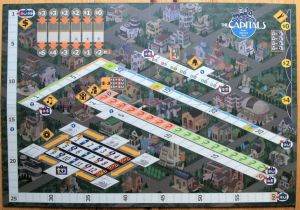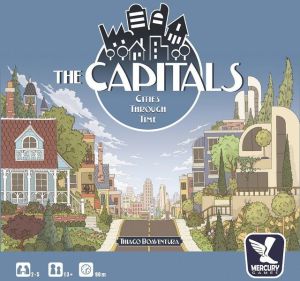Design by Thiago Boaventura
Published by Mercury Games
2 – 5 Players, 2 – 3 hours
Review by Greg J. Schloesser
City-building games have always held an attraction for me, as I enjoy watching the city (or cities) expand and develop. Some are relatively simple and abstract—such as Manhattan—while others are more complex and involved (think La Citta and Suburbia). One of the earliest I remember playing was Sid Sackson’s Metropolis, which I adored, mainly because of the impressive 3D pieces.
In recent years Suburbia by designer Ted Alspach proved popular, but I grew weary of constantly having to examine opponents’ cities in order to determine the effects and scoring of the tiles I played into my own city. The absence of this constant examination of opponents’ cities is one of the attractions of The Capitals: Cities Through Time, a mostly overlooked city-building game from designer Thiago Boaventura and Mercury Games. The game has not received much attention from gamers, which is a shame as it is really interesting and challenging.
The theme is familiar: developing and growing a city. However, the twist is that this is done over the course of three eras, very loosely progressing from the Victorian age to modern times. Players each plan and develop their own city, mostly without any interference from their opponents. This is not really “multi-player solitaire,” however, as there is keen competition for desired buildings and features, as well as a fierce race to be the premier city in terms of cultural, financial and public service advancements.
 The central board is primarily designed to track players’ progress and status in a variety of categories, including population, employment, finances, initiative, culture, public service, etc. Players will each build and expand their own city by placing tiles into their burgeoning metropolis. When tiles are placed, they usually affect—positively or negatively–one or more of the aforementioned categories. Players must carefully plan their city, as the placement of each tile can be critical, and one wants to optimize his advancement in these various categories.
The central board is primarily designed to track players’ progress and status in a variety of categories, including population, employment, finances, initiative, culture, public service, etc. Players will each build and expand their own city by placing tiles into their burgeoning metropolis. When tiles are placed, they usually affect—positively or negatively–one or more of the aforementioned categories. Players must carefully plan their city, as the placement of each tile can be critical, and one wants to optimize his advancement in these various categories.
Players begin with two tiles representing the beginnings of their city—City Hall and Hotel—as well as a small Coal Plant, which provides the energy for the stadt. Energy is vital, as it is used to power various buildings in one’s city, allowing the player to use their effects. Thus, the more energy, the more options and abilities a player has at his disposal. Increasing one’s energy supply by upgrading one’s power plants is a key feature of the game. There is a race to do this, as the earlier an advanced power plant is grabbed, the more benefits it provides.
 The building tiles are at the heart of The Capitals. The tiles are divided into three eras, and each tile represents a specific building or feature. Tiles are divided into categories—housing, industry, commerce, public, prosperity, etc.—and will usually indicate immediate and varied effects. These effects generally increase or decrease one’s status on several of the tracks. The varied effects can often be triggered repeatedly if a player activates the tile on future turns, which usually costs energy.
The building tiles are at the heart of The Capitals. The tiles are divided into three eras, and each tile represents a specific building or feature. Tiles are divided into categories—housing, industry, commerce, public, prosperity, etc.—and will usually indicate immediate and varied effects. These effects generally increase or decrease one’s status on several of the tracks. The varied effects can often be triggered repeatedly if a player activates the tile on future turns, which usually costs energy.
One of the clever—and costly—features in the game is determining initiative. Players place their markers on the initiative track to determine the turn order. Going early in the turn order gives a player an advantage, especially when selecting new buildings for their city. However, this advantage comes at a steep cost, as the player must pay a hefty sum (up to $18) to go early in turn order. Each turn the initiative is re-determined, with the player going first the previous turn selecting his slot first. Unless the player is fabulously wealthy (not likely), he will be forced to select a lower position the following round. This is a clever mechanism that really does help jostle turn order from round-to-round. It also has the effect of forcing players to deplete their treasury regularly.
After determining initiative, players select a building tile from the three rows, paying the required cost. Tiles in the first row are free, but those in rows two and three cost $2 and $4 respectively. A selected tile must immediately be placed in one’s city. As mentioned, placement can be critical, as many tiles yield benefits by being placed next to certain tiles. However, a player is somewhat restricted in where he may place a tile. First, a tile must be placed adjacent to a tile of the same type, with diagonal considered adjacent. Further, it must be placed in one of the eight locations as dictated by his two “construction tokens.” Each player has two of these tokens, which are shaped like small crosses. A newly acquired tile must be placed in one of the four spaces around one of these crosses. These construction tokens can be moved once the four areas around it are occupied by tiles. Placing in an area not by these tiles is possible, but it costs money. This represents city planning, and requires a player to look into the future and plan ahead.
When a tile is placed, the immediate effects as listed on the tile are triggered, which, as mentioned, usually affects a player’s status on the various tracks. Some effects are triggered when a tile is constructed adjacent to it, while others are triggered when the tile is activated by expending energy cubes.
After placing tiles, player advance their “Tourist” marker based on their position on the Culture track. The tourist track is important as the player who is furthest along may attract other players’ tourist markers to their own city, which basically gives the player an additional energy cube for the upcoming turn. This additional marker may not seem like a big advantage, but it is usually a significant advantage. Thus, players should at least try to make sure they keep their own marker and not have it defect to an opponent.
 Players then activate their tiles, expending energy cubes to do so as indicated on the respective tiles they wish to activate. Players can upgrade their power plants by progressing on the Progress track, which is done by acquiring certain tiles. The better the power plant, the more energy cubes one has at his disposal, which means the more tiles he can activate. In this game, more is better.
Players then activate their tiles, expending energy cubes to do so as indicated on the respective tiles they wish to activate. Players can upgrade their power plants by progressing on the Progress track, which is done by acquiring certain tiles. The better the power plant, the more energy cubes one has at his disposal, which means the more tiles he can activate. In this game, more is better.
At the end of each era, which occurs at the end of turns 4, 8 and 12, there is a “World Expo Evaluation,” otherwise known as a scoring. Several tracks are examined to determine the effects they have on the players. For example, players gain or lose points based on their progress on the Employment track, lose points if they have a high unemployment rate, and adjust their status on other tracks based on their public services.
At the end of round 12 the game ends. Players earn points in a variety of fashions, including end game bonuses for certain buildings, excess energy cubes, money, and progress on the Culture and Progress tracks. Players must keep a careful eye on all of these facets to insure that they optimize their scores.
The Capitals is an intricate, rather complex city-building game that requires players to carefully consider and manage numerous factors in their quest to construct the ideal city. The city tracks alone require the player to be an adept juggler, as neglecting any one of them can cause significant problems and setbacks. For example, employment is a major source of prestige (victory) points, so high employment is very desirable. However, employment can never be greater than population, so one must constantly be seeking to increase population. These two must be balanced, however, as high population with low employment is a recipe for disaster.
There are similar factors and obstacles to face with each of the tracks.
Building tiles also present a multitude of quandaries. While they usually help a player progress in certain areas, they often cause a player to regress in other areas. For example, the Market allows a player to advance on the Progress and Employment tracks, but at the expense of losing ground on the Public Services track. It is often a matter of two steps forward, one step backward.
The game does eliminate the hassle of having to check every opponents’ cities when placing a new tile to determine the overall effect of that placement. One only has to concentrate on one’s own city…and that can be enough of a chore. Each tile placement does require a player to examine not only the adjacent tiles, but often all tiles, to see what effects are triggered. This can get tedious, and can occasionally result in an oversight or mistake. Couple this with the regular adjustments to the various tracks and the overload of icons and you have a game that is quite fiddly.
Still, in spite of this, I find the game challenging, engaging and fun to play. Managing and balancing the numerous aspects is daunting, and the clever initiative mechanism also forces some tough decisions. Sure, there are aspects I do not care for, but the overall experience is still very worthwhile. This certainly won’t be a game to suit everyone’s taste, but those seeking a rather detailed and intricate city-building game filled with an abundance of choices and management decisions should be well pleased.
Thoughts of Other Opinionated Gamers:
Dale Yu:
And to answer the question that I’m sure people will ask – yes, this game is different than Suburbia. The rules are more complex and there is a much different feel to the game. I think this is due to the multiple tracks that you have to manage in Capitals instead of just money and VP in Suburbia. This is more of a gamer’s game for city building. Capitals is more like Sim City: the boardgame, though more playable than SC:TBG. [obligatory disclaimer – in case it wasn’t clear, I am the developer of Suburbia, and therefore have a vested interest in that game…]
While my final verdict still remains to be seen, I will say that after our most recent game, everyone at the table remarked that they wanted to play it again soon – and that’s a positive sign for any game.
Ratings:
4 (Love it!):
3 (Like it): Greg S., Dale Yu
2 (Neutral):
1 (Not for me):


I don’t find the checking everyone’s city aspect of Suburbia that much of a hassle, it just connects everyone’s game a little more.
A more complex Suburbia is intriguing, but I think I’ll stick with Sub.
Thanks for the overview! I had not heard of this one before.
if you are a victim of this online investment scam promising you heavy returns, is 100% sure you will get your refund of your scammed money back as long as you have every detail of this scam broker, message me at alexvictimhelp01 at gmail dot com